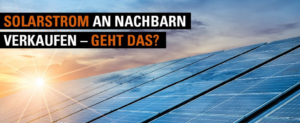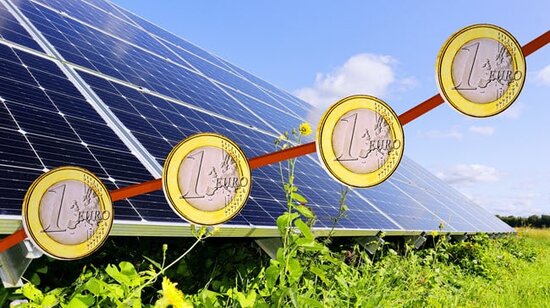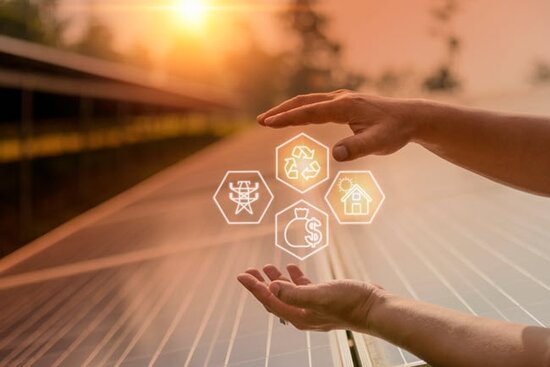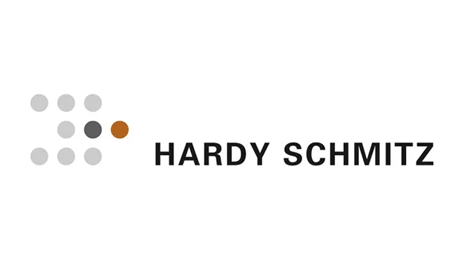 Marketing of solar power – simply sell surplus to neighbors
Marketing of solar power – simply sell surplus to neighbors
With falling feed-in tariffs and numerous photovoltaic systems that have been phased out, many operators are asking themselves how they can best market excess solar power. Traditionally, the solar energy that is not used by the user can of course be fed into the public grid.
However, the market is dynamic and today there are various alternatives to sell your own surplus production. The new business models offer a wide range of options: from going public to selling to your neighbors, almost anything is possible.
Sell the solar power to public operators
Surely everyone is familiar with the grid feed-in and it is quite simple. Solar power from your own photovoltaic system that you cannot use yourself is fed into the public grid. The solar system operator receives a payment for this – the feed-in tariff. And for many decades this was a worthwhile concept.
Due to the falling feed-in tariffs, however, this marketing variant is increasingly being questioned by solar system operators. The feed-in tariff, which was contractually secured upon commissioning, is valid for 20 years. However, after this period has expired, the fed-in solar power will be accepted at the current conditions.

And if the electricity price is higher than the remuneration for feeding it into the grid, it certainly makes more economic sense to focus on maximum self-consumption or to consider alternative business models for selling your own solar power.
Sell PV electricity directly to tenants or neighbors
The idea of simply selling the self-generated solar power to tenants or neighbors is obvious. And with the current pricing of the electricity suppliers, solar system operators can actually sell their green eco-power at more attractive prices.
Although the costs for self-produced green electricity can vary depending on the size and equipment of the photovoltaic system, average costs of around 10 cents per kilowatt hour can be expected. This contrasts with an average of 37 cents, which cost consumers one kilowatt hour of electricity in the first half of 2022.
The current feed-in tariffs, which are around 6 cents (March 2022), and the early abolition of the EEG levy also speak in favor of the concept of sharing your own solar power commercially with neighbours, the municipality and also companies in the neighborhood.
The Stromcloud – a clever alternative
Strictly speaking, this is not about selling your own solar energy. Rather, the principle works like a virtual electricity storage system. A power cloud promises, as we already know from a data cloud from the IT sector, that the green electricity from the company’s own photovoltaic system is stored.
If in summer your own solar system produces a lot of electricity that you cannot use yourself, then it flows into the electricity cloud or electricity community. An electricity supplier does not pay a feed-in tariff, but the solar system operator has an electricity credit. This can be called up and used at times with little sunlight, such as in winter or during the night.
In practice, however, your own electricity is not actually stored, but is immediately available to all users of the electricity cloud for consumption. This means that the energy from the electricity credit that is used at a later point in time is not your own, but one that was produced at the relevant point in time. Thus, all PV operators of the Stromcloud together ensure that a continuous supply of green electricity is guaranteed.
Direct marketing of your own surplus solar power
Another way to sell your own solar power is direct marketing. So a direct sale of the solar power fed into the public grid via a direct marketer. And this option is also economical and pays off compared to the EEG remuneration – both for new systems and for existing systems.
The electricity from renewable energy sources is marketed on the electricity exchange using the so-called market premium model. And for this, direct marketers are usually commissioned by solar system operators. The system operator receives remuneration for the electricity supply, which is made up of the sales proceeds from the direct marketer and the market premium, including the management premium, from the responsible grid operator.
Photovoltaic systems that were put into operation after January 1, 2016 and have an output of more than 100 kW are obliged to sell them directly. On the other hand, smaller solar system operators can choose whether they prefer feed-in tariffs or direct marketing.
Community electricity – 100% green electricity directly from the producer
Another alternative is the so-called Bürgerstrom der Bürgerwerke eG. Bürgerwerke is an association of more than 50,000 people and 110 local energy communities throughout Germany. They offer 100% energy supply from renewable energy systems. The TÜV and the Grüner Strom Label guarantee the origin through regular tests.
Electricity from solar, wind and water power as well as green gas from organic residues is generated and distributed regionally and decentrally. For this purpose, the generation capacities of many small generation plants in Germany are bundled. The green energy is sold to both private households and companies.

Under the Dachgenossenschaft Bürgerwerke eG, regional citizens’ energy cooperatives are grouped together with the aim of regionalizing the energy supply and promoting a decentralized energy transition. The cooperatives currently operate over 1,400 renewable energy systems and operators of larger solar systems can sell their PV electricity directly to the citizen energy cooperatives.
The EEG regulations for the direct marketing of solar power
The basic regulations for the direct marketing of PV electricity were laid down for the first time in the EEG amendment from 2012 (§ 33a – i EEG 2012). This made it possible to continue operating through direct marketing when the legally guaranteed 20-year EEG remuneration expires.
According to the current EEG regulations, there is a mandatory and an optional direct marketing:
- Mandatory direct marketing
- If the photovoltaic system was put into operation after January 1, 2016 and the output is more than 100 kW, the operators are obliged to sell it directly.
- Optional direct marketing
- Smaller system operators can also go into direct marketing, even if they still benefit from the feed-in tariff. The switch between direct marketing and EEG remuneration can take place at the beginning of each month.
If a solar system operator opts for direct marketing or is obliged to do so due to the size of the system, then a number of technical requirements and requirements must be met. For this purpose, the solar system must have technical equipment that enables the marketing company to call up the actual feed-in at any time and to regulate the feed-in power remotely. Here it is important to weigh up whether this additional investment in the technology actually pays off for smaller systems whose operators are aiming for direct marketing.
Source
Hardy Schmitz Group
EMR Analysis
More information on Hardy Schmitz: https://www.hardy-schmitz.de + With a very broad and deep product portfolio of over 300,000 branded products from well-known manufacturers, one of the largest cable warehouses in Germany, our branch network and a comprehensive range of services, we offer the best quality, innovative products and reliable, fast delivery. With our company motto ELECTROLOGISTICS WITH SERVICEPLUS, we guarantee our customers tailor-made solutions and the best results in the implementation of their projects.
In addition to first-class and constantly expanding ranges of electrical engineering and industrial electrics, we guarantee our customers a reliable network of suppliers.Our sophisticated storage and logistics system also enables not only a 24-hour delivery service, but also, if desired, just-in-time deliveries directly to production, to the machine or to the construction site.
Our distinctive customer orientation as well as our range of exclusively high-quality products and a comprehensive portfolio of innovative services are the key to our success.
Progress is a tradition for our company and as an innovative system service provider, our customers benefit from individual, tailor-made optimization processes in procurement. We attach great importance to recognizing the special requirements of our customers and offering them individual solutions that we implement effectively together.
Our goal is to make procurement processes along the entire value chain efficient. Preserve existing values and create new ones for and with our business partners. Therefore, we maintain a sustainable, partnership relationship with our customers, suppliers and employees.
In addition, HARDY SCHMITZ plans and manufactures individual low-voltage switchgear and controls. And we are competently at your side in the areas of cable logistics, KNX project planning, e-mobility and lighting planning.
More information on Jan Schmitz (Managing Partner & Chairman of the Management Board, Hardy Schmitz): See the full profile on EMR Executive Services
More information on The Renewable Energy Sources Act (Erneuerbare-Energien-Gesetz; EEG): https://www.bmwk.de/Redaktion/EN/Dossier/renewable-energy.html + The Renewable Energy Sources Act (EEG), which entered into force in 2000, is a key driving force for the expansion of renewable energy in Germany. The 2014 revision of the Renewable Energy Sources Act was an important step towards setting the energy transition on a path to success.
More information on Bürgerwerke eG: https://buergerwerke.de/ + The Bürgerwerke are an association of more than 50,000 people and 110 local energy communities from all over Germany. Together we supply people nationwide with renewable community electricity from solar, wind and hydropower as well as citizen eco-gas from organic residues. We are pursuing the vision of a renewable, regional and independent energy future in the hands of the people. Because people have grandchildren, energy companies don’t.
More information on TÜV Rheinland: https://www.tuv.com/world/en/ + TÜV Rheinland stands for safety and quality in virtually all areas of business and life. Founded almost 150 years ago, the company is one of the world’s leading testing service providers with more than 20,600 employees and annual revenues of around 2 billion euros. TÜV Rheinland’s highly qualified experts test technical systems and products around the world, support innovations in technology and business, train people in numerous professions and certify management systems according to international standards. In doing so, the independent experts generate trust in products as well as processes across global value-adding chains and the flow of commodities. Since 2006, TÜV Rheinland has been a member of the United Nations Global Compact to promote sustainability and combat corruption.
More information on the Grüner Strom Label: https://www.gruenerstromlabel.de/ + The Certification of green energy products
The seal of approval named Grüner Strom is granted for green electricity 100 % sourced from renewable energy. The seal of approval named Grünes Gas is granted for biogas sourced by genuinely environmentally friendly means. Green electricity and biogas product options bearing the Grüner Strom label or the Grünes Gas label offer significant environmental advantages.
Both seals are granted by the Grüner Strom Label e.V. Association (“GSL”). GSL’s supporters are seven non-profit organizations, including environmental-, consumer information groups and peace-furthering organizations. Grüner Strom and Grünes Gas are the only seals of approval for green electricity and biogas in Germany, indicating endorsement by leading environmental organizations.
EMR Additional Notes:
- Grid, Microgrids and DERs:
- The power grid is a network for delivering electricity to consumers. The power grid includes generator stations, transmission lines and towers, and individual consumer distribution lines.
- The grid constantly balances the supply and demand for the energy that powers everything from industry to household appliances.
- Electric grids perform three major functions: power generation, transmission, and distribution.
- A microgrid is a small-scale power grid that can operate independently or collaboratively with other small power grids. The practice of using microgrids is known as distributed, dispersed, decentralized, district or embedded energy production.
- Smart Grid is any electrical grid + IT at all levels . Micro Grid is a group of interconnected loads and DERs (Distributed energy resources) within a clearly defined electrical and geographical boundaries witch acts as a single controllable entity with respect to the main grid.
- Distributed energy resources (DERs) are small-scale electricity supply (typically in the range of 3 kW to 50 MW) or demand resources that are interconnected to the electric grid. They are power generation resources and are usually located close to load centers, and can be used individually or in aggregate to provide value to the grid.
- Common examples of DERs include rooftop solar PV units, natural gas turbines, microturbines, wind turbines, biomass generators, fuel cells, tri-generation units, battery storage, electric vehicles (EV) and EV chargers, and demand response applications.
- Feed-in Tariff (FIT):
- Policy designed to support the development of renewable energy sources by providing a guaranteed, above-market price for producers.
- Also known as standard offer contract or advanced renewable tariff, are policy mechanisms that are designed to accelerate investment in renewable energy systems and technologies. They achieve this by offering long-term contracts to renewable energy producers, typically based on the cost of generation of each different technology. Technologies like wind power, for instance, are awarded a lower per-kWh price, whereas technologies like solar, photovoltaic, and tidal or wave power are currently offered a higher price, reflecting their higher costs.
- In addition, FiT often include “tariff degression,” a mechanism according to which the price (or tariff) ratchets down over time. This is done to track and encourage technological cost reductions. The goal of FiT is ultimately to offer cost-based compensation to renewable energy producers, providing the price certainty and long-term contracts that help finance renewable energy investments

